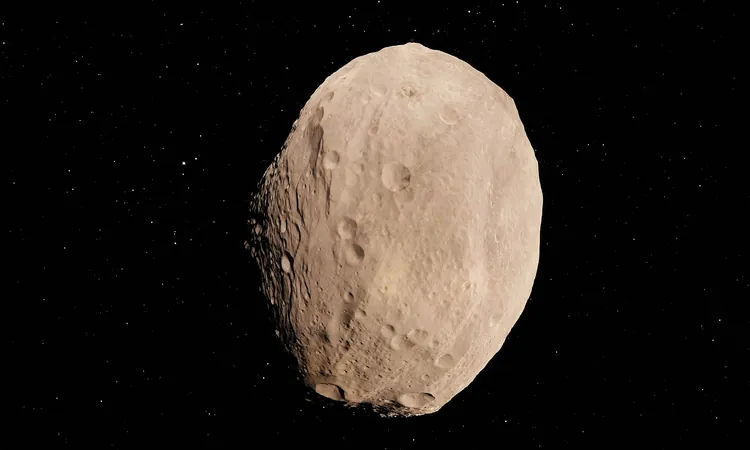
Asteroid Vesta Surprises Scientists with Water-like Gullies
2024-12-26
Author: Rajesh
Asteroid Vesta Surprises Scientists with Water-like Gullies
In the cosmic expanse of the asteroid belt between Mars and Jupiter, asteroids have long been known for their rugged terrains marked by craters from relentless impacts over billions of years. Among them, the asteroid Vesta has recently captured the attention of scientists, not only for its battle-scarred surface but for unexpected channels that resemble gullies formed by flowing liquid.
When NASA's Dawn spacecraft made its historic visit to Vesta, it unveiled more than just the telltale signs of cosmic collisions. The spacecraft discovered deep channels that appeared to have been shaped by some form of liquid water, raising serious questions about the role of water on an object that lacks an atmosphere.
The Mystery of Vesta's Channels
These compelling channels suggest that there may be hidden reservoirs of ice lying beneath the surface of Vesta. Scientists were left wondering how any liquid could persist long enough to erode the landscape without quickly evaporating in the vacuum of space. This baffling quandary prompted a research team, led by Michael J. Poston from the Southwest Research Institute, to conduct laboratory simulations to replicate Vesta’s conditions.
Using NASA’s specialized facility known as the DUSTIE (Dirty Under-vacuum Simulation Testbed for Icy Environments), researchers subjected samples of saline water to low-pressure conditions resembling those on Vesta. The results were astonishing: while pure water froze almost instantaneously, water infused with salt (brine) exhibited a significant delay in freezing, remaining liquid long enough to create the flowing gullies seen in the spacecraft images.
Jennifer Scully, a scientist at NASA’s Jet Propulsion Laboratory, highlighted the implications of these findings: "Not only do impacts trigger a flow of liquid on the surface, but these liquids can remain active long enough to mold distinctive surface features."
Asteroid Vesta: A Potential Reservoir of Ice
Although direct evidence of ice on Vesta remains elusive, further analysis of its surface features, such as crater walls and gullies, is ongoing. Researchers believe that if ice deposits are eventually confirmed, it would bolster the theory that many asteroids house more moisture than previously thought beneath their dusty surfaces.
This discovery has broader implications not only for Vesta but also for other celestial bodies. Active gullies on Mars, which appear seasonally, may share similar processes with Vesta’s saline flows. Although the Martian atmosphere is thin, briny water could remain stable during specific conditions, shedding light on the potential for liquid existence elsewhere in our solar system.
Redefining Our Understanding of the Asteroid Belt
The findings brought forth by the Dawn mission have sparked a significant shift in how we perceive the asteroid belt. Previously regarded as a barren wasteland, these new revelations suggest that the asteroid belt could host fleeting bursts of liquid may be more common than previously accounted for.
Researchers continue to investigate how impacts can catalyze brief moments of liquid flow, detectable on moon-like bodies across the solar system. This ongoing study not only advances our understanding of Vesta specifically, but also opens the door to a new perspective on the evolutionary trajectory of celestial bodies and the hidden chemistry that shapes planets and moons throughout the cosmos.
With more investigations on the horizon, the tantalizing mystery of Vesta and its watery gullies leaves scientists eagerly anticipating the next revelations from this ancient space rock. As we expand our search for liquid water beyond Earth, Vesta might just be the gateway to understanding our solar system's hidden secrets!
 Brasil (PT)
Brasil (PT)
 Canada (EN)
Canada (EN)
 Chile (ES)
Chile (ES)
 Česko (CS)
Česko (CS)
 대한민국 (KO)
대한민국 (KO)
 España (ES)
España (ES)
 France (FR)
France (FR)
 Hong Kong (EN)
Hong Kong (EN)
 Italia (IT)
Italia (IT)
 日本 (JA)
日本 (JA)
 Magyarország (HU)
Magyarország (HU)
 Norge (NO)
Norge (NO)
 Polska (PL)
Polska (PL)
 Schweiz (DE)
Schweiz (DE)
 Singapore (EN)
Singapore (EN)
 Sverige (SV)
Sverige (SV)
 Suomi (FI)
Suomi (FI)
 Türkiye (TR)
Türkiye (TR)
 الإمارات العربية المتحدة (AR)
الإمارات العربية المتحدة (AR)